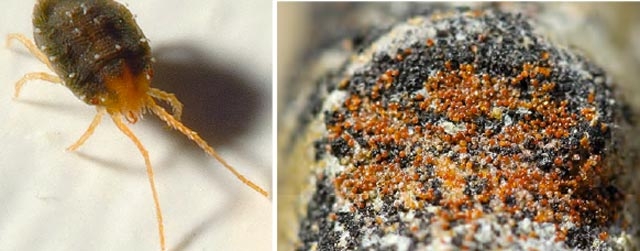Bryobia mites feed on the leaves of fruit trees by puncturing the leaf tissues with their sucking mouthparts.
Bryobia mites have become more prevalent in recent years as pest and disease control programs have moved away from broad-spectrum chemicals.
Pest identification
Adult mites are broad and flat, approximately 0.5 mm long and deep reddish-brown.
Their front set of legs are as long as the body. They are often seen pressed flat against the leaf surface or as masses of red eggs on branches and stems.
Without a microscope or good hand lens, bryobia mite may be confused with European red mite.
Damage
Bryobia mites damage the leaves by sucking sap, generally feeding on the upper surface of the leaves.
Damage from this feeding appears as whitish-grey spots giving the leaf a stippled appearance. Heavily infested leaves will become pale and can prematurely fall. Fruit growth is rarely affected.
There are several ways to quantify the risk posed by mite populations, including counts, presence or absence, percentage of leaves infested and cumulative leaf infested days (CLIDS).
Your local IPM consultant or chemical reseller should be able to assist with more advice on applying these methods in your orchard.
Monitoring
Monitor for bryobia mites fortnightly from late spring to summer.
More frequent monitoring might be needed if conditions are hot and dry as this accelerates pest development.
Random inspection of leaves across the orchard using a hand lens can be a good way to detect early mite activity. Leaf samples should be collected and inspected using a microscope to determine the number of eggs, active mites and predatory mites and other beneficial insects present.
Commercial mite monitoring services exist in some growing regions.
Management
Cultural and physical
Dusty environments favour pest mite activity.
If weather conditions are hot and dry, orchard traffic should be limited and operators should drive slowly to limit the dust on trees.
Maintaining a green ground cover can reduce dust whilst also providing an attractive alternative habitat for beneficial predatory insects.
Take particular care to control tall or climbing weeds that provide a bridge between other mite hosts and trees.
Biological
Bryobia mite can be controlled by predatory mites including Galendromus pyri.
Other naturally occurring biological control agents of pest mites include lacewings and stethorus beetles.
Careful selection of IPM friendly insecticides and fungicides will help to encourage predatory mites and other beneficials. Consult your chemical supplier for the least disruptive options.
Chemical
An effective chemical control program for pest mites usually includes a winter (dormant) or early spring (budswell, green-tip) oil spray to control overwintering eggs, followed by targeted miticide application(s) during the growing season as determined by monitoring.
Download the Orchard plant protection guide 2020-21
See this article in Tree Fruit Feb 2020




















